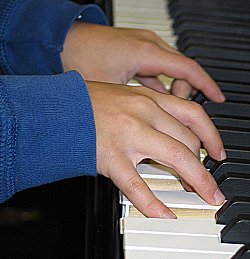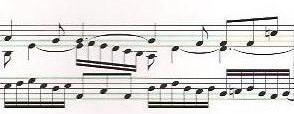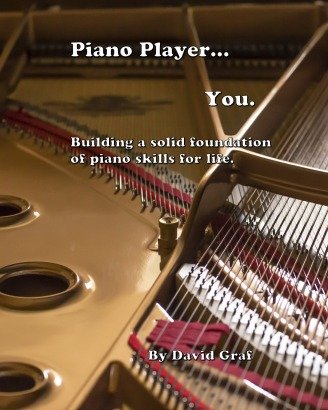The purpose of this website: helping you learn to play the piano. Building a strong foundation of piano-playing skills will lead to a lifetime of piano-playing joy.
How To Practice Piano

Learn how to practice piano well and you will discover the secret to playing the piano. Learn to practice and to love your practicing, and success is yours.
If you want a thorough understanding of what and how you can effectively practice every time you sit at the piano to work, you may want to consider the e-book: Piano Player... You (see image and link below). Chapter 2 of this book covers the topic of practice in very specific, easy-to-understand detail. A brief summary follows here, but for the complete plan... consider getting the book.
For most amateur pianists, the biggest obstacle to development is not knowing how to practice.
With a high quality daily routine of consistent and effective practice, applied over a period of years, anyone can develop into a confident and competent piano player, capable of playing whatever they want and with the skills to freely express themselves at the piano.
The following practice methods are highly effective and enjoyable in that they produce results and they offer a pianist a solid plan for how to practice piano everyday.
For a more complete understanding of how to build your piano-playing foundation, read
For the most direct, organized, and progressive path to learning to play the piano, start
the Piano Skills Foundation series of piano lessons.
(Advertisement)
How To Practice Piano: Exercises And Scales (Technique)
The following methods describe how to practice piano scales & arpeggios, as well as exercises of all kinds:
The Basic Metronome Workout

The following method shows how to practice piano using the metronome.
-Work just one phrase, or passage, at a time. Start with a very slow and easy tempo.
-Work hand separately, first (if both hands are playing simultaneously in the exercise).
-Once you feel confident mastery of each individual phrase/passage, move the tempo up a couple of notches and repeat the process.
-Continue working at faster and faster tempos until you start to feel challenged beyond your comfort zone.
(You should always be able to keep the rhythm and the notes even and steady, and keep your arms and shoulders free of tension while you play.)
-If you are working on a long exercise, or etude, work on individual passages from slow to fast, and then start stringing them together at slow-to-fast tempos.
How To Practice Piano: Links + Metronome
- Divide your exercise into 1-, 2-, and/or 4-beat “links” (like chain links), or 1-, 2-, and/or 4-measure links. (If playing 16th notes, divide into beats. If playing quarter notes or eighth notes, divide into measures.)
- Play each link from its first note to the first note of the next link (thus, linking them together). You will be playing in short spurts, stopping on the first note of each link, and then starting on that same note for the next link. (The first notes always get played twice; the last note of one link is the first note of the next.)
-Start with short links, mastering the notes and the rhythm for each link. Use the metronome to help keep it even and steady, starting at a slow and easy tempo.
-Expand the length of the links (from 1-beat links to 2-beat links, or from 2-beat links to 4-beat links, etc…), still at the slow and easy tempo.
-Keep lengthening the links until you are playing the entire passage, phrase, or scale with no stops, at the slow and easy tempo.
-With each phrase/passage, repeat this process over and over, gradually working up to faster and faster tempos on the metronome.
-Continue working at faster and faster tempos until you start to feel challenged beyond your comfort zone.
(Rhythms and notes must be steady and even, shoulders and arms relatively relaxed.)
How To Practice Piano: Rhythm Variations
Scales and exercises with long runs of one type of rhythm (i.e.: all 16th notes, or all eighths), can be practiced in varying rhythms:
-Decide what kind of groupings you are going to use: groups of 3’s (best with triplets), 4’s (best with eighths and 16ths), or even 6’s (good with triplets, or eighths in compound meter <6/8-time>).
-Play the entire run of notes pausing on the first note of each group. An example of groups of 4’s:
1----2341----2341----2341----2341----2341---, etc…(saying these numbers helps)
-Next, play the entire run of notes pausing on the second note of each group:
12----3412----3412----3412----3412----3412----, etc…(say the numbers while you play)
-Next, play the entire run of notes pausing on the third note of each group:
123----4123----4123----4123----4123----4123----etc…(say the numbers!)
-Next, play the entire run of notes pausing on the fourth note of each group:
1234----1234----1234----1234----1234----1234----etc…(say the numbers)
-Make sure that the notes in between the pauses are fast (eventually) and even, and that the hands are exactly together.
-Use the pauses (which can be as long as you want them to be, but not too short) to think ahead for the next group of notes, as well as to remind your arms and shoulders to relax.
-After playing all of the rhythmic variation once or twice, try playing the rhythm as it should be (with all even 16ths, etc…) and you should find that it seems much easier now.
How To Practice Piano: Music Reading

To begin learning how to practice piano music reading, make sure you are working on music that is at your reading level: music reading skills will always be 1 or 2 levels below your actual playing ability. (See Chapter 6 of Piano Player...You.) Sightreading skills are usually 2 or 3 levels below your playing ability, and 1 or 2 levels below your basic reading ability.
“Piano Method” books offer the best and most well-organized way of developing reading skills. I highly recommend the Hal Leonard Student Piano Library. (Go To "Sheet Music Plus" to find these, or any other method books.)
Once you have the appropriately-leveled music to work with, this is how to practice piano music reading:
-Divide the music into phrases/passages. The great majority of western music compositions come in 4-measure phrases.
-Work on just one phrase at a time, overlapping into the next phrase by at least one beat (thus, linking the two phrases together).
-Play the phrase with just the right hand (or left; it does not matter which hand goes first), slowly. Count the rhythm out loud (especially if you are specifically working on your reading skills), and keep your eyes on the music. Try not to look at your hands at all (big jumps could be the exception, though not necessarily).
-Repeat the phrase as many times as it takes to become familiar and comfortable with the notes, rhythms, and fingerings.
-Repeat the same process on the same phrase with the left hand.
-Once you are proficient on the phrase with each hand separately, repeat the process with both hands. This may require you to go slower, as it is usually a bit more difficult.
-Play the phrase with both hands (remembering to overlap at least one beat into the next phrase) until you have played it perfectly 3 times or more. I call this the “3-Perfect” or “3P” rule. (As you reach more advanced levels of piano music, you will probably need to make it the “5-Perfect” or “10-Perfect” rule.)
-Repeat the entire process with every phrase until you know and can play them all. Every time you complete the process for a phrase, play it together with the one(s) you have already worked.
-By the second or third time you practice a piece this way, you should include the metronome for all of it (go slow enough and you may be able to use metronome from the beginning). Start at easy tempos and work your way up the dial until faster tempos are just as easy.
(The previously recommended Hal Leonard Student Piano Library has exact tempo markings for students to work towards. This is a great element of these particular method books because it helps teachers and students know just how long to stay with any given piece, and because the student can then play the piece with the accompaniment CDs, which is fun and great for musical development.)
-Throughout this whole practicing process, remember these two rules for developing music reading skills:
1. KEEP EYES ON THE MUSIC! (No looking at your hands.)2. COUNT OUT LOUD! (Counting in your head allows too many errors. Count out loud until you’ve been at the piano for at least 3 or 4 years.)
As you learn how to practice piano music reading, your reading skills will grow and your love of reading music will grow!
How To Practice Piano For Memorizing Music
To learn how to practice piano music when you know you want to memorize a piece, start memorizing it while you learn it. By learning and memorizing at the same time, you will develop a more reliable and confident mastery of the music. (Chapter 7 of Piano Player... You makes the case.)
The following practice method will help you simultaneously learn and memorize a piece of music at the piano.
-Divide the music into its natural musical phrases/passages. Often, phrases come four-measure groups. (You can just pencil-in large parentheses around each phrase on the page.)
-Divide phrases into two-measure-links, or even one-measure-links. For memorizing music, it is best to start with small links. The higher the complexity of the music, the smaller the links should be. (I’ve even had to memorize in one-beat-links, pieces by Bach and Rachmaninoff.) I like to just draw straight vertical lines through the music to divide phrases into chunks.
-Figure out the notes, rhythms, and fingerings for the right hand on the first small (let’s say 2-measures) link. Play the right hand part slowly up to and including the first beat of the next link.
-Repeat it over and over until you know it and can play it by memory, looking at the keys. Having the visual image of the music on the keys is helpful, so don’t close your eyes, or look off into space.
-Figure out the notes, rhythms, and fingerings for the left hand on the same link. Play the left hand part slowly up to and including the first beat of the next link.
-Repeat it over and over until you know it and can play it by memory, looking at the keys.
-Once this first link is memorized and playable with each hand separately, play the hands together slowly until you have played it perfectly at least 3 times (with more advanced music, try to get at least 5-10 perfects), by memory.
-Repeat the process for the next link.
-Once you have all the links of a phrase/passage learned and memorized and playable at a slow speed, play the entire phrase, stopping on the first note of each link.
-By playing a phrase with stops on each link, you are putting “trail markers” into the music so that you never get lost as you play through the whole piece (very helpful for live performances.)
-Repeat the process phrase by phrase, passage by passage, until you know the entire piece.
-Day by day, it is important to maintain the phrases you already have learned by continuing to practice each phrase in links, right hand, left hand, both. Thus, you will find that you really can only learn one or two new phrases each day, while at the same time maintaining previously-learned phrases.
-Once you have learned and memorized an entire piece, continue working in links. With a complex and difficult piece, keep using short links (one-measure, or two-measure links). With less difficult and complex pieces, you will do just fine with four-measure links (usually an entire phrase.)
-Use the metronome with your links practice to push the tempo up to the level you would want for performance.
-When working in links, make sure you include musical elements: musical shaping, dynamics, articulation.
-Practicing in links to learn and memorize a piece, and to continue preparing the piece for performance, will produce a confident and free playing of the music, with fewer mistakes and virtually no memory slips. Also, pieces learned in this fashion will last longer in your memory and be more readily re-learnable.
The above described practice routine can
be used on piano pieces from the beginning levels all the way up to the
most advanced. I have my students learning and memorizing music from
Martha Mier’s “Hamster Chase” to Beethoven’s Waldstein Sonata using
these methods, and they all achieve performance level memorization with
tremendous confidence. They also learn to love practicing, seeing how
it produces such great results.
Some people are simply interested in the academic side of piano playing. If that is you, music theory is the way to go. Wikipedia's Music Theory is pretty awesome.

If you want to see a blueprint for a successful piano journey...
read
"Piano Player... You"
A guide to building a solid and complete piano-playing foundation.
-Click here to learn more about this e-book-
If you would like a step-by-step guide to help you on your piano journey...
start working through
"The Piano Skills Foundation" piano lessons
-Click here to learn more about this piano course-
Return from "How To Practice Piano" to "How To Play Piano"
Looking for some piano music?
I have found Sheet Music Plus to be a fantastic resource for piano books & other materials. And they have instant digital downloads for thousands of individual pieces.
3 Ways To Support This Website
If you enjoy using true-piano-lessons.com and would like to help support it:
1. Buy the ebook, "Piano Player... You"
2. Purchase "Piano Skills Foundation"
3.Donation
